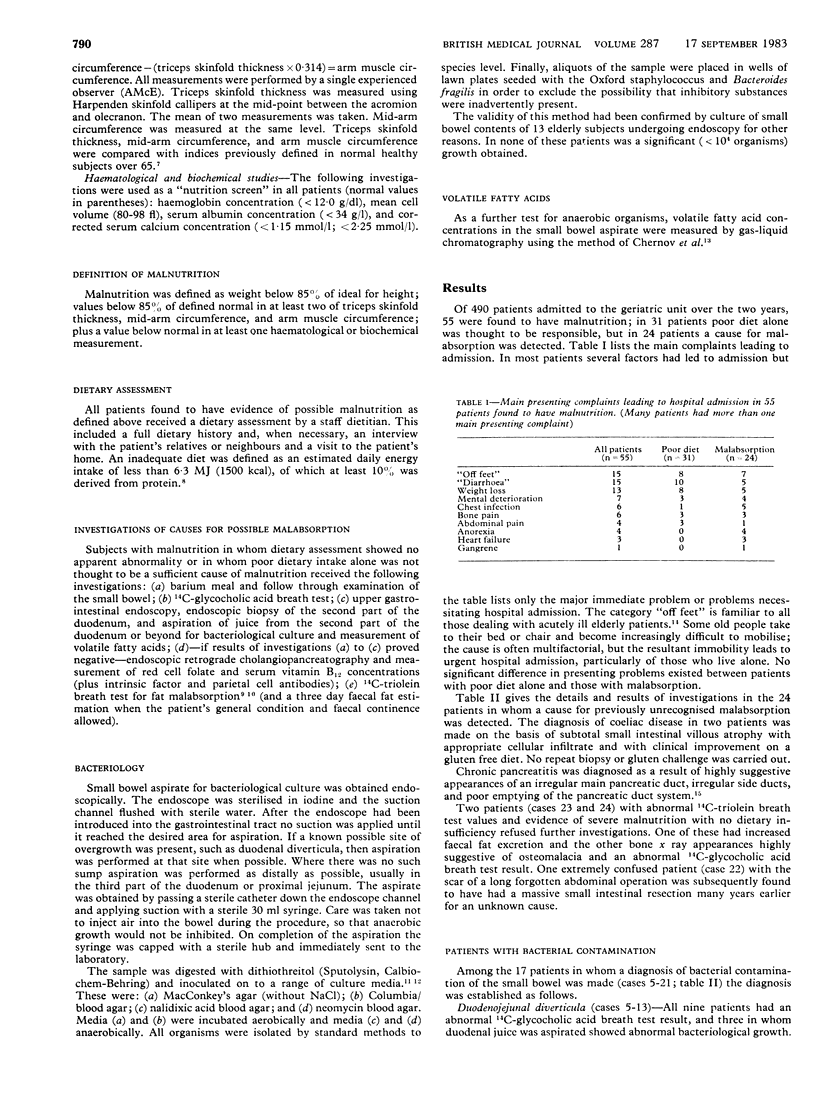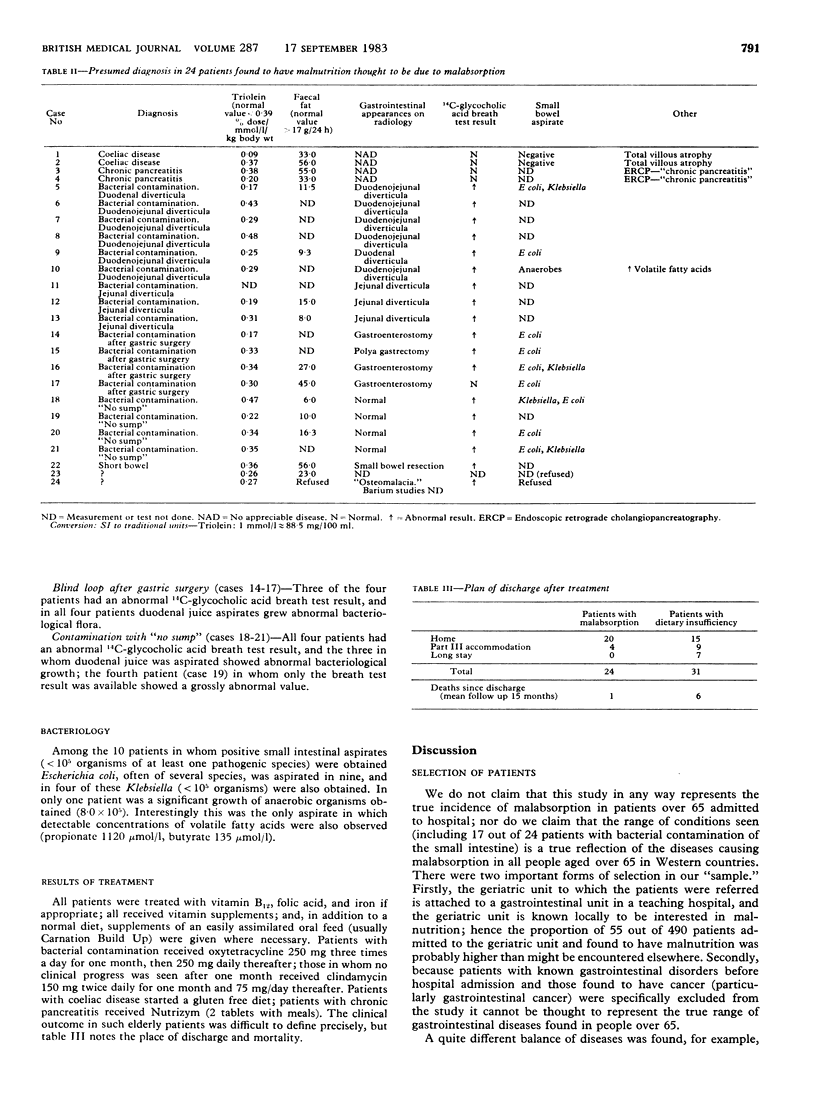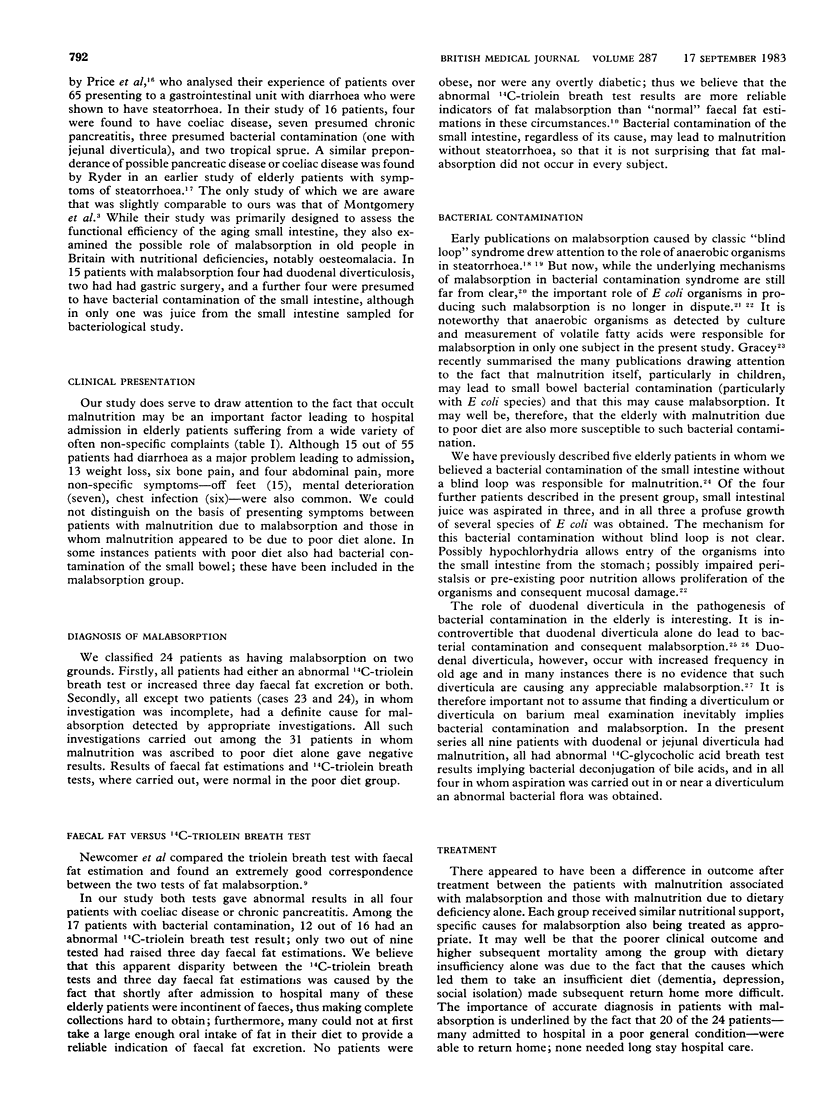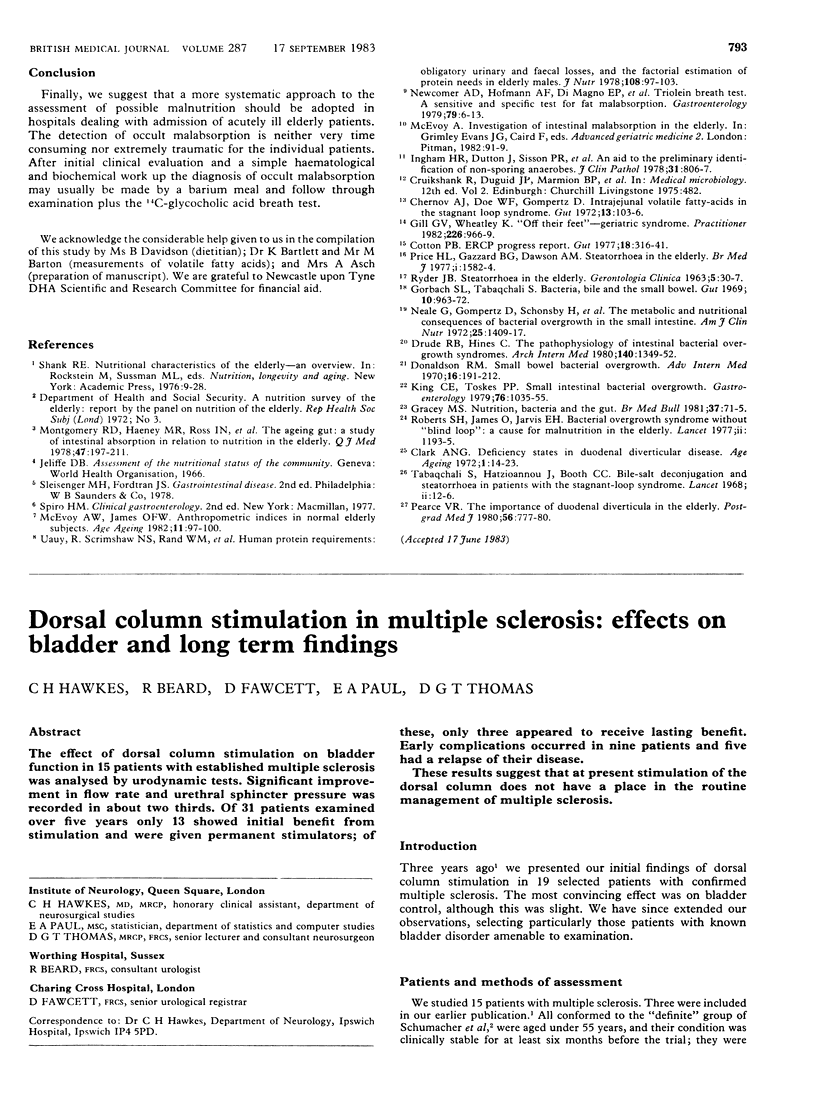Abstract
A study was conducted to examine the contribution that occult malabsorption makes to malnutrition among elderly patients admitted to an acute geriatric ward. Malnutrition was defined by anthropometric, haematological, and biochemical measurements. Out of 490 patients, 55--many of whom had presented with non-gastrointestinal symptoms--were found to be malnourished. In 31 poor diet alone was probably the cause, but in the remaining 24 patients previously unrecognised malabsorption was detected. Of these patients, 17 were found to have bacterial contamination of the small bowel (nine with duodenojejunal diverticula, four after gastric surgery, and four diagnosed as contamination with "no sump"). In 10 patients contamination was confirmed by culture of intestinal juice: Escherichia coli was predominant in nine cases, and anaerobic organisms in one. Small bowel bacterial overgrowth without a "blind loop" or obvious underlying cause has not previously been fully proved in the elderly. Coeliac disease was detected in two patients, and chronic pancreatitis in two. Occult malabsorption is an important cause of malnutrition in the elderly. Such malnutrition not infrequently occurs in geriatric patients presenting to hospital with non-specific symptoms of physical deterioration.
Full text
PDF




Selected References
These references are in PubMed. This may not be the complete list of references from this article.
- Chernov A. J., Doe W. F., Gompertz D. Intrajejunal volatile fatty acids in the stagnant loop syndrome. Gut. 1972 Feb;13(2):103–106. doi: 10.1136/gut.13.2.103. [DOI] [PMC free article] [PubMed] [Google Scholar]
- Cotton P. B. ERCP. Gut. 1977 Apr;18(4):316–341. doi: 10.1136/gut.18.4.316. [DOI] [PMC free article] [PubMed] [Google Scholar]
- Donaldson R. M., Jr Small bowel bacterial overgrowth. Adv Intern Med. 1970;16:191–212. [PubMed] [Google Scholar]
- Drude R. B., Jr, Hines C., Jr The pathophysiology of intestinal bacterial overgrowth syndromes. Arch Intern Med. 1980 Oct;140(10):1349–1352. [PubMed] [Google Scholar]
- Gill G. V., Wheatley K. E. 'Off their feet'--a geriatric syndrome. Practitioner. 1982 May;226(1367):966–969. [PubMed] [Google Scholar]
- Gorbach S. L., Tabaqchali S. Bacteria, bile, and the small bowel. Gut. 1969 Dec;10(12):963–972. doi: 10.1136/gut.10.12.963. [DOI] [PMC free article] [PubMed] [Google Scholar]
- Gracey M. S. Nutrition, bacteria and the gut. Br Med Bull. 1981 Jan;37(1):71–75. doi: 10.1093/oxfordjournals.bmb.a071679. [DOI] [PubMed] [Google Scholar]
- Ingham H. R., Dutton J., Sisson P. R., Sprott M. S., Selkon J. B. An aid to the preliminary identification of non-sporing anaerobes. J Clin Pathol. 1978 Aug;31(8):806–807. doi: 10.1136/jcp.31.8.806. [DOI] [PMC free article] [PubMed] [Google Scholar]
- King C. E., Toskes P. P. Small intestine bacterial overgrowth. Gastroenterology. 1979 May;76(5 Pt 1):1035–1055. [PubMed] [Google Scholar]
- McEvoy A. W., James O. F. Anthropometric indices in normal elderly subjects. Age Ageing. 1982 May;11(2):97–100. doi: 10.1093/ageing/11.2.97. [DOI] [PubMed] [Google Scholar]
- Montgomery R. D., Haeney M. R., Ross I. N., Sammons H. G., Barford A. V., Balakrishnan S., Mayer P. P., Culank L. S., Field J., Gosling P. The ageing gut: a study of intestinal absorption in relation to nutrition in the elderly. Q J Med. 1978 Apr;47(186):197–124. [PubMed] [Google Scholar]
- Neale G., Gompertz D., Schönsby H., Tabaqchali S., Booth C. C. The metabolic and nutritional consequences of bacterial overgrowth in the small intestine. Am J Clin Nutr. 1972 Dec;25(12):1409–1417. doi: 10.1093/ajcn/25.12.1409. [DOI] [PubMed] [Google Scholar]
- Newcomer A. D., Hofmann A. F., DiMagno E. P., Thomas P. J., Carlson G. L. Triolein breath test: a sensitive and specific test for fat malabsorption. Gastroenterology. 1979 Jan;76(1):6–13. [PubMed] [Google Scholar]
- Pearce V. R. The importance of duodenal diverticula in the elderly. Postgrad Med J. 1980 Nov;56(661):777–780. doi: 10.1136/pgmj.56.661.777. [DOI] [PMC free article] [PubMed] [Google Scholar]
- Price H. L., Gazzard B. G., Dawson A. M. Steatorrhoea in the elderly. Br Med J. 1977 Jun 18;1(6076):1582–1584. doi: 10.1136/bmj.1.6076.1582. [DOI] [PMC free article] [PubMed] [Google Scholar]
- RYDER J. B. Steatorrhoea in the elderly. Gerontol Clin (Basel) 1963;5:30–37. doi: 10.1159/000244771. [DOI] [PubMed] [Google Scholar]
- Roberts S. H., James O., Jarvis E. H. Bacterial overgrowth syndrome without "blind loop": A cause for malnutrition in the elderly. Lancet. 1977 Dec 10;2(8050):1193–1195. doi: 10.1016/s0140-6736(77)90436-6. [DOI] [PubMed] [Google Scholar]
- Tabaqchali S., Hatzioannou J., Booth C. C. Bile-salt deconjugation and steatorrhoea in patients with the stagnant-loop syndrome. Lancet. 1968 Jul 6;2(7558):12–16. doi: 10.1016/s0140-6736(68)92888-2. [DOI] [PubMed] [Google Scholar]
- Uauy R., Scrimshaw N. S., Rand W. M., Young V. R. Human protein requirements: obligatory urinary and fecal nitrogen losses and the factorial estimation of protein needs in elderly males. J Nutr. 1978 Jan;108(1):97–103. doi: 10.1093/jn/108.1.97. [DOI] [PubMed] [Google Scholar]


